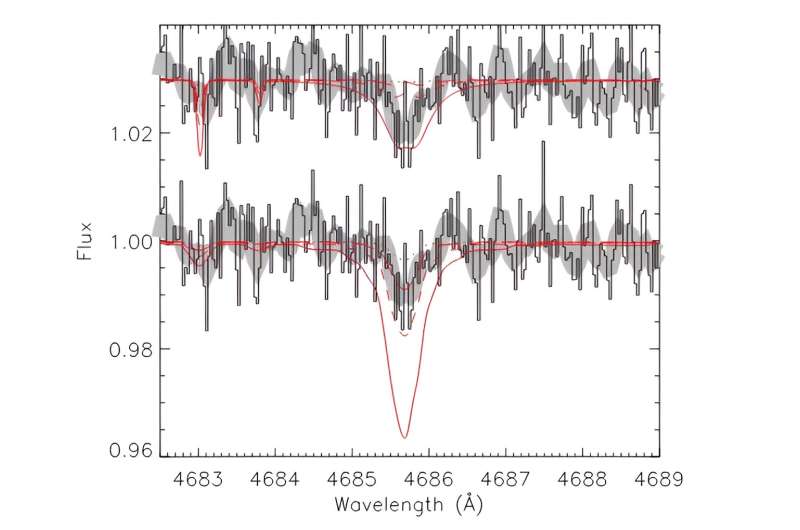April 17, 2024 report
This article has been reviewed according to Science X's editorial process and policies. Editors have highlighted the following attributes while ensuring the content's credibility:
fact-checked
preprint
trusted source
proofread
Astronomers discover the most metal-poor extreme helium star

Using the Southern African Large Telescope (SALT), astronomers have performed high-resolution observations of a recently detected extreme helium star designated EC 19529–4430. It turned out that EC 19529–4430 is the most metal deficient among the population of known extreme helium stars. The finding was reported in a research paper published April 5 on the pre-print server arXiv.
Extreme helium (EHe) stars are supergiants much larger and hotter than the sun, but less massive. They are almost devoid of hydrogen, which is unusual, as hydrogen is the most abundant chemical element in the universe.
EHes are characterized by relatively sharp and strong lines of neutral helium, which indicates low surface gravities and atmospheres dominated by helium. Besides helium, these stars also have significant amounts of carbon, nitrogen and oxygen. The First EHe star was detected in 1942.
EC 19529−4430 is a recently discovered EHe in the Galactic halo, located at a distance of about 15,500 light years. It has an effective temperature of 18,540 K and its surface appears to be composed primarily of carbon-nitrogen-oxygen (CNO)-processed helium.
A team of astronomers led by Simon Jeffery of the Armagh Observatory and Planetarium in Armagh, UK, has decided to further investigate EC 19529−4430 in order to shed more light on its true nature. For this purpose, they employed SALT's High Resolution Spectrograph (HRS) and Robert Stobie Spectrograph (RSS).
SALT observations found that EC 19529−4430 has an effective temperature of 20,700 K and an overall metallicity at a level of -1.3 dex. The nitrogen was found to be 1.2 dex overabundant, while carbon and oxygen were measured to be 1.5 and 0.7 dex underabundant, respectively.
The study confirmed that the surface of EC 19529−4430 consists principally of CNO-processed helium. It also confirmed that the star belongs to the Galactic halo, which is consistent with its low overall metallicity, and is on a retrograde orbit. The astronomers added that no pulsations from this star have been identified so far.
All in all, the results indicate that EC 19529−4430 is the most metal-poor EHe star detected to date. Moreover, it turns out that it is also the coolest known carbon-poor and nitrogen-rich EHe star.
Trying to explain the origin of EC 19529−4430, the authors of the paper suppose that it is most likely a result of a merger of two helium white dwarfs.
"It is most likely that EC 19529−4430 formed from the merging of two helium white dwarfs, which themselves formed as a binary system some 11 billion years ago, and that it will evolve to become a core helium-burning EHe subdwarf," the researchers conclude.
More information: Simon Jeffery et al, EC 19529-4430: SALT identifies the most carbon- and metal-poor extreme helium star, arXiv (2024). DOI: 10.48550/arxiv.2404.03972
Journal information: arXiv
© 2024 Science X Network





















